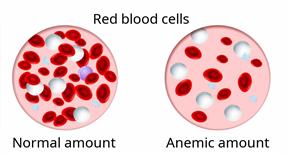Anemia

Anemia is a condition in which there are not enough red blood cells or hemoglobin in the blood. Hemoglobin is a substance in red blood cells that carries oxygen.
When you do not have enough red blood cells or hemoglobin (are anemic), your body cannot get enough oxygen, and your organs may not work properly. As a result, you may feel very tired or have other problems.
What are the causes?
Common causes of anemia include:
Excessive bleeding. Anemia can be caused by excessive bleeding inside or outside the body, including bleeding from the intestines or from heavy menstrual periods in females.
Poor nutrition.
Long-lasting (chronic) kidney, thyroid, and liver disease.
Bone marrow disorders, spleen problems, and blood disorders.
Cancer and treatments for cancer.
Human immunodeficiency virus (HIV) and acquired immunodeficiency syndrome (AIDS).
Infections, medicines, and autoimmune disorders that destroy red blood cells.
What are the signs or symptoms?
Symptoms of this condition include:
Minor weakness.
Dizziness.
Headache, or difficulties concentrating and sleeping.
Heartbeats that feel irregular or faster than normal (palpitations).
Shortness of breath, especially with exercise.
Pale skin, lips, and nails, or cold hands and feet.
Upset stomach (indigestion) and nausea.
Symptoms may occur suddenly or develop slowly. If your anemia is mild, you may not have symptoms.
How is this diagnosed?
This condition is diagnosed based on blood tests, your medical history, and a physical exam. In some cases, a test may be needed in which cells are removed from the soft tissue inside of a bone and looked at under a microscope (bone marrow biopsy). Your health care provider may also check your stool (feces) for blood and may do more testing to look for the cause of your bleeding.
Other tests may include:
Imaging tests, such as a CT scan or MRI.
A procedure to see inside your esophagus and stomach (endoscopy). The esophagus is the part of the body that moves food from your mouth to your stomach.
A procedure to see inside your colon and rectum (colonoscopy).
How is this treated?
Treatment for this condition depends on the cause. If you continue to lose a lot of blood, you may need to be treated at a hospital. Treatment may include:
Taking supplements of iron, vitamin B12, or folic acid.
Taking a hormone medicine (erythropoietin) that can help to stimulate red blood cell growth.
Receiving donated blood through an IV (blood transfusion). This may be needed if you lose a lot of blood.
Making changes to your diet.
Having surgery to remove your spleen.
Follow these instructions at home:
-
Take over-the-counter and prescription medicines only as told by your health care provider.
-
Take supplements only as told by your health care provider.
-
Follow any diet instructions that you were given by your health care provider.
-
Keep all follow-up visits. Your health care provider will want to recheck your blood tests.
Contact a health care provider if:
-
You are short of breath.
-
You have pain in your abdomen or chest.
-
You are dizzy or feel faint.
-
You have trouble concentrating.
-
You have bloody stools, black stools, or tarry stools.
-
You vomit repeatedly or you vomit up blood.
These symptoms may be an emergency. Get help right away. Call 911.
Summary
-
Anemia is a condition in which you do not have enough red blood cells or enough of a substance in your red blood cells that carries oxygen.
-
Symptoms may occur suddenly or develop slowly.
-
If your anemia is mild, you may not have symptoms.
-
This condition is diagnosed with blood tests, a medical history, and a physical exam. Other tests may be needed.
-
Treatment for this condition depends on the cause of the anemia.
This information is not intended to replace advice given to you by your health care provider. Make sure you discuss any questions you have with your health care provider.
